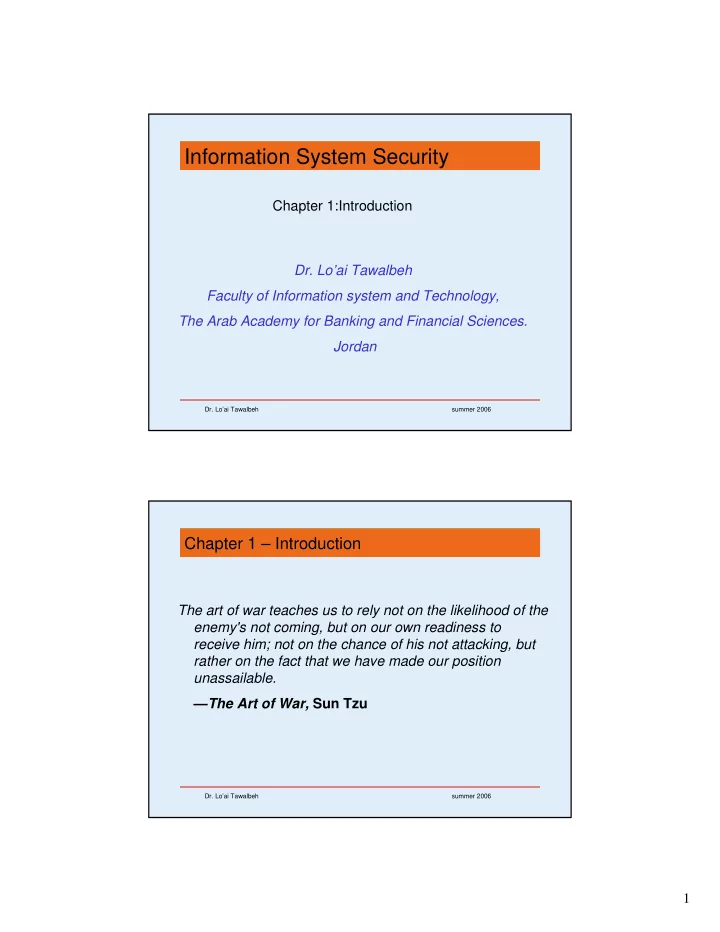

Information System Security Chapter 1:Introduction Dr. Lo’ai Tawalbeh Faculty of Information system and Technology, The Arab Academy for Banking and Financial Sciences. Jordan Dr. Lo’ai Tawalbeh summer 2006 Chapter 1 – Introduction The art of war teaches us to rely not on the likelihood of the enemy's not coming, but on our own readiness to receive him; not on the chance of his not attacking, but rather on the fact that we have made our position unassailable. — The Art of War, Sun Tzu Dr. Lo’ai Tawalbeh summer 2006 1
Background • Information Security requirements have changed in recent times • traditionally provided by physical and administrative mechanisms • computer use requires automated tools to protect files and other stored information • use of networks and communications links requires measures to protect data during transmission Dr. Lo’ai Tawalbeh summer 2006 Definitions • Computer Security - generic name for the collection of tools designed to protect data and to thwart hackers • Network Security - measures to protect data during their transmission • Internet Security - measures to protect data during their transmission over a collection of interconnected networks Dr. Lo’ai Tawalbeh summer 2006 2
Aim of Course • our focus is on Internet Security • consists of measures to deter, prevent, detect, and correct security violations that involve the transmission of information Dr. Lo’ai Tawalbeh summer 2006 Services, Mechanisms, Attacks • need systematic way to define requirements • consider three aspects of information security: • security attack • security mechanism • security service • consider in reverse order Dr. Lo’ai Tawalbeh summer 2006 3
Security Service • is something that enhances the security of the data processing systems and the information transfers of an organization • intended to counter security attacks • make use of one or more security mechanisms to provide the service • replicate functions normally associated with physical documents • eg have signatures, dates; need protection from disclosure, tampering, or destruction; be notarized or witnessed; be recorded or licensed Dr. Lo’ai Tawalbeh summer 2006 Security Mechanism • a mechanism that is designed to detect, prevent, or recover from a security attack • no single mechanism that will support all functions required • however one particular element underlies many of the security mechanisms in use: cryptographic techniques • hence our focus on this area Dr. Lo’ai Tawalbeh summer 2006 4
Security Attack • any action that compromises the security of information owned by an organization • information security is about how to prevent attacks, or failing that, to detect attacks on information-based systems • have a wide range of attacks • can focus of generic types of attacks • note: often threat & attack mean same Dr. Lo’ai Tawalbeh summer 2006 OSI Security Architecture • ITU-T X.800 Security Architecture for OSI • defines a systematic way of defining and providing security requirements • for us it provides a useful, if abstract, overview of concepts we will study Dr. Lo’ai Tawalbeh summer 2006 5
Security Services • X.800 defines it as: a service provided by a protocol layer of communicating open systems, which ensures adequate security of the systems or of data transfers • RFC 2828 defines it as: a processing or communication service provided by a system to give a specific kind of protection to system resources • X.800 defines it in 5 major categories Dr. Lo’ai Tawalbeh summer 2006 Security Services (X.800) • Authentication - assurance that the communicating entity is the one claimed • Access Control - prevention of the unauthorized use of a resource • Data Confidentiality –protection of data from unauthorized disclosure • Data Integrity - assurance that data received is as sent by an authorized entity • Non-Repudiation - protection against denial by one of the parties in a communication Dr. Lo’ai Tawalbeh summer 2006 6
Security Mechanisms (X.800) • specific security mechanisms: • encipherment, digital signatures, access controls, data integrity, authentication exchange, traffic padding, routing control, notarization • pervasive security mechanisms: • trusted functionality, security labels, event detection, security audit trails, security recovery Dr. Lo’ai Tawalbeh summer 2006 Classify Security Attacks as • passive attacks - eavesdropping on, or monitoring of, transmissions to: • obtain message contents, or • monitor traffic flows • active attacks – modification of data stream to: • masquerade of one entity as some other • replay previous messages • modify messages in transit • denial of service Dr. Lo’ai Tawalbeh summer 2006 7
Model for Network Security Dr. Lo’ai Tawalbeh summer 2006 Model for Network Security • using this model requires us to: • design a suitable algorithm for the security transformation • generate the secret information (keys) used by the algorithm • develop methods to distribute and share the secret information • specify a protocol enabling the principals to use the transformation and secret information for a security service Dr. Lo’ai Tawalbeh summer 2006 8
Model for Network Access Security Dr. Lo’ai Tawalbeh summer 2006 Model for Network Access Security • using this model requires us to: • select appropriate gatekeeper functions to identify users • implement security controls to ensure only authorised users access designated information or resources • trusted computer systems can be used to implement this model Dr. Lo’ai Tawalbeh summer 2006 9
Summary • have considered: • computer, network, internet security def’s • security services, mechanisms, attacks • X.800 standard • models for network (access) security Dr. Lo’ai Tawalbeh summer 2006 10
Recommend
More recommend